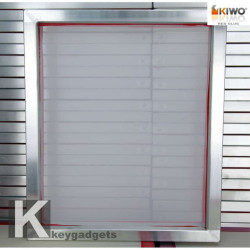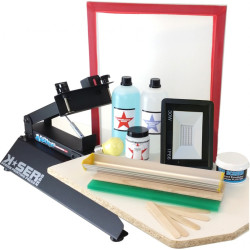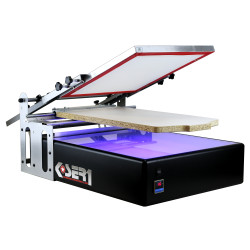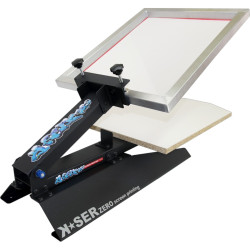The Perfect Screen Printing Machine for T-Shirts and
Textiles: Everything You Need to Know
Do you want to enter the world of screen
printing or upgrade your existing screen printing machine? In this article you
will find comprehensive information about screen printing machines for
textiles, what to look for when buying one and which models are suitable for
your needs. Whether you are a professional or a beginner, this guide will help
you make the right decision.
table of contents
1.
What is a screen printing machine and why is it indispensable?
2.
How does the screen printing process work?
3.
What types of screen printing machines are there?
4.
What should you pay attention to when buying a screen printing machine?
5.
Manual, semi-automatic or fully automatic: Which machine is right for
you?
6.
Which materials can be printed with a screen printing machine?
7.
What are the best brands and models on the market?
8.
How to choose the right machine for high volumes?
9.
Tips for the care and maintenance of your screen printing machine
10.
Conclusion: Screen printing as a durable and versatile printing
technique
1. What is a screen printing machine and why is it essential?
A screen
printing machine is a device designed to apply ink to various surfaces such
as textiles, plastic or wood using a screen. Especially when making T-shirts
and other garments, screen printing offers the possibility of creating
long-lasting and opaque prints of high quality.
Why is it essential? The efficiency and
accuracy of modern screen printing machines make it possible to produce both
small and large runs cost-effectively and with consistent quality. Whether you
want to screen print hoodies or print jackets, the possibilities are almost
endless.
2. How does the screen printing process work?
In screen printing, a stencil is applied to a fine-mesh screen. The ink is pressed
through the open areas of the screen onto the material to be printed using a
squeegee. The process is characterized by the ability to produce opaque and long-lasting prints on
textiles.
A big advantage is the flexibility: the screen
printing process can be used to create both small and large format designs. The
use of water-based or special screen printing inks makes the technology
particularly environmentally friendly and versatile.
3. What types of screen printing machines are there?
There are different types of screen printing machines that are
tailored to different requirements:
·
Manual machines : Ideal for beginners and
smaller runs. A manual printing table enables precise work at low cost.
·
Semi-automatic machines : Combine manual
control with automated processes. Perfect for medium runs and greater
efficiency.
·
Fully automatic machines : The best choice for
professionals and industrial companies that need to print high volumes with
maximum efficiency.
One example is the HDT1000 , a compact and powerful semi-automatic machine suitable
for both beginners and professionals.
4. What should you pay attention to when buying a screen
printing machine?
When purchasing
a screen printing machine , you should consider the following points:
11.
Printing area and print size : For T-shirts
and hoodies, a printing plate of at least 38 x 54 cm is ideal.
12.
Printable materials : Make sure the machine is
compatible with textiles, plastic or other desired materials.
13.
Level of automation : Decide whether a manual,
semi-automatic or fully automatic machine better suits your needs.
14.
Value for money : Consider whether a new
machine is required or whether a used model
on platforms such as eBay offers a cheaper alternative.
5. Manual, semi-automatic or fully automatic: Which machine
is right for you?
Manually
Perfect for smaller budgets and small
production quantities. A manual screen printing machine, such as the classic
hand printing table, is easy to use and is ideal for beginners.
semi-automatic
Ideal for companies looking to print
medium-sized runs , these machines
combine manual intervention with automated processes, increasing efficiency and
reducing costs.
Fully automatic
These machines, like the M&R model , offer the highest printing speed and precision.
They are particularly suitable for high print runs in industry and professional textile printing companies.
6. Which materials can be printed with a screen printing
machine?
A modern screen printing machine can print on a wide variety of materials :
·
Textiles : T-shirts, hoodies, jackets and
other garments.
·
Plastic : advertising materials and signs.
·
Wood and ceramics : creative projects and
decorative applications.
·
Special materials : polyester and water-based
fabrics for sustainable projects.
7. What are the best brands and models on the market?
Leading manufacturers and models
·
M&R : Specialized in fully automatic
machines for high volumes.
·
Thieme : Offers durable machines with
innovative technology.
·
Fleischle : Known for precise and compact
machines.
One of the most popular models for beginners
is the Keygadgets Beginner Kit , which
includes everything you need to get started.
8. How to choose the right machine for high volumes?
If you want to print large quantities , efficiency and speed are
crucial. The following aspects play a role:
·
Print speed : Fully automatic machines with
pneumatic print heads offer maximum speed.
·
Durability : Choose a machine made of
high-quality materials to ensure a long life.
·
Competitiveness : Invest in a machine that
allows you to remain competitive even on large projects.
9. Tips for the care and maintenance of your screen printing
machine
Regular maintenance increases the longevity of your screen printing
machine:
·
Cleaning : Remove excess ink and residue after
each printing process.
·
Stencil Care : Make sure your screen printing frames are clean and in
good condition.
·
Spare parts : Keep important spare parts such
as squeegees or printing plates on hand to minimize downtime.
10. Conclusion: Screen printing as a durable and versatile
printing technique
Screen printing offers an ideal solution for
creative, durable and opaque prints
on a wide range of materials. Whether you want to print t-shirts for personal
use or in large quantities , the
right screen printing machine makes
all the difference.
Summary of the most important points
·
Screen printing is a versatile printing technique for textiles and other
materials.
·
Choose between manual , semi-automatic and fully
automatic machines, depending on your needs.
·
Consider the print size, materials
and price before purchasing a machine .
·
Care and maintenance are crucial
for the longevity of your machine.
·
Invest in high-quality models to
remain competitive even with large print
runs .
A printing
press is the heart of many production processes, especially in the field of
textile printing. Modern printing machines make it possible to transfer
high-quality designs onto T-shirts, hoodies and other textiles - and at
impressive speed and precision. There are models for every requirement, from
simple manual machines for small runs to fully automatic systems that are used
in industry to produce large quantities efficiently.
A multi-colour
screen printing machine opens up creative possibilities for implementing
complex designs in bright colours on textiles such as T-shirts and hoodies. It
is ideal, especially for high print runs, to ensure consistent quality.
Textile printing
offers a wide range of options for customizing clothing such as T-shirts
and hoodies. Screen printing in particular offers long-lasting, opaque results
that are suitable for professional and creative applications.
Screen printing
on textiles is one of the most popular methods for transferring durable and
high-quality designs onto t-shirts, hoodies and other fabrics. This technique
is characterized by its versatility, as it is ideal for both simple and complex
multi-colored motifs.
Screen printing yourself is a great way to put individual designs on T-shirts, bags or other textiles. With a set for beginners, consisting of a screen printing frame, squeegee and water-based paint, creative ideas can be implemented easily and inexpensively.










